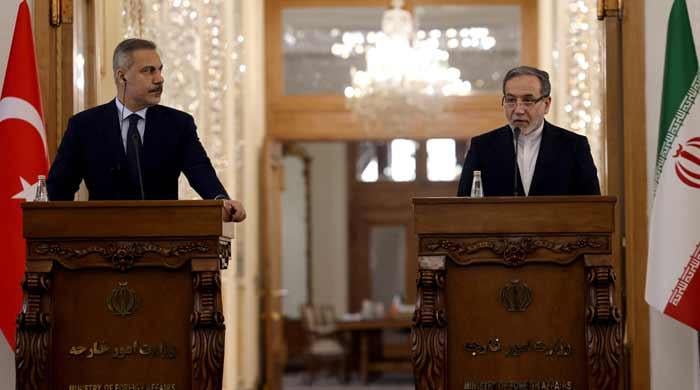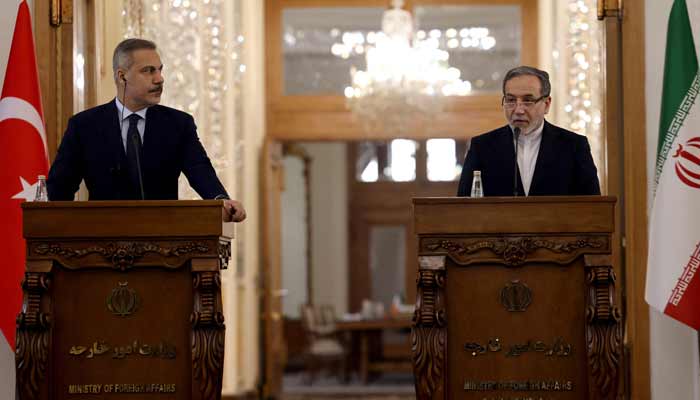Politics
US govt shutdown begins as partisan division rules Washington


- Shutdown halts critical economic data, affects federal workers.
- Senate rejects spending measure, deepens partisan divide.
- Analysts warn shutdown could last longer than past closures.
WASHINGTON: The US government shut down much of its operations on Wednesday as deep partisan divisions prevented Congress and the White House from reaching a funding deal, setting off what could be a long, gruelling standoff that could lead to the loss of thousands of federal jobs.
There was no clear path out of the impasse, while agencies warned that the 15th government shutdown since 1981 would halt the release of a closely watched September employment report, slow air travel, suspend scientific research, withhold pay from US troops and lead to the furlough of 750,000 federal workers at a daily cost of $400 million.
Trump, whose campaign to radically reshape the federal government is already on track to push out some 300,000 workers by December, warned congressional Democrats that a shutdown could clear the path for “irreversible” actions, including cutting more jobs and programs.
The shutdown commenced hours after the Senate rejected a short-term spending measure that would have kept government operations afloat through November 21.
Democrats opposed the legislation over Republicans’ refusal to attach an extension of health benefits for millions of Americans, which are due to expire at the end of the year. Republicans say the issue must be addressed separately.
At issue on the government funding front is $1.7 trillion for agency operations, which amounts to roughly one-quarter of the government’s total $7 trillion budget. Much of the remainder goes to health and retirement programs and interest payments on the growing $37.5 trillion debt.
Independent analysts warn the shutdown could last longer than the budget-related closures of the past, with Trump and White House officials threatening to punish Democrats with cuts to government programs and the federal payroll.
Trump budget director Russell Vought, who has called for “less bipartisan” appropriations, threatened permanent layoffs last week in the event of a shutdown.
Nonpartisan measure devoid of partisan policy riders
The longest government shutdown in US history stretched over 35 days during December 2018 and January 2019 during Trump’s first term in office, in a dispute over border security.
“All they want to do is try to bully us. And they’re not going to succeed,” Senate Democratic leader Chuck Schumer said in a floor speech a day after a White House meeting with Trump and other congressional leaders that ended with the two parties far apart.
Senate Majority Leader John Thune described the failed short-term spending bill as a “nonpartisan” measure devoid of partisan policy riders that Democrats have had no problem accepting in years past.
“What’s changed is that President Trump is in the White House. That’s what this is about. This is politics. And there isn’t any substantive reason why there ought to be a government shutdown,” the South Dakota Republican told reporters.
Trump’s Republicans hold majorities in both chambers of Congress, but legislative rules require 60 of the 100 senators to agree on spending legislation. That means that at least seven Democrats are needed to pass a funding bill.
Focus on healthcare funding
Democrats are under pressure from their frustrated supporters to score a rare victory ahead of the 2026 midterm elections that will determine control of Congress for the final two years of Trump’s term.
The healthcare push has given them a chance to unite behind an issue that resonates with voters.
Along with the extended health subsidies, Democrats have also sought to ensure that Trump will not be able to undo those changes if they are signed into law.
Trump has refused to spend billions of dollars approved by Congress, prompting some Democrats to question why they should vote for any spending legislation at all.
University of Chicago professor Robert Pape said the unusually polarised US political climate in the aftermath of conservative activist Charlie Kirk’s assassination and the growing power on the extreme wings of both parties could make it harder for party leaders to agree on a deal to reopen the government.
“The rules of politics are radically changing and we can’t know for sure where all of this is going to end,” said University of Chicago political science professor Robert Pape, who studies political violence.
“Each side would have to backtrack against tens of millions of truly aggressive supporters, their own constituents, which is going to be really hard for them to do,” he said.
Before the shutdown, Trump reached out to his own supporters with a deepfake video showing manipulated images of Schumer appearing to criticise Democrats while top House Democrat Hakeem Jeffries stood next to him, with a crudely drawn sombrero and mustache imposed over his face.
“It was childish. It was petty,” Schumer told reporters. “It’s something that a five-year-old would do, not a president of the US. But it shows how unserious they are. They don’t give a damn about the harm they will cause with their shutdown.”
Politics
Trump says US freeze on asylum decisions will last ‘a long time’


- Freeze applies to 19 countries already under US travel restrictions.
- Lakanwal, ex-CIA-backed fighter, charged with first-degree murder.
- Officials blame weak Joe Biden-era airlift vetting for shooter’s entry.
US President Donald Trump said Sunday his administration intends to maintain a pause on asylum decisions for “a long time” after an Afghan national allegedly shot two National Guard members near the White House, killing one of them.
When asked to specify how long it would last, Trump said he had “no time limit” in mind for the measure, which the Department of Homeland Security says is linked to a list of 19 countries already facing US travel restrictions.
“We don’t want those people,” Trump continued. “You know why we don’t want them? Because many have been no good, and they shouldn’t be in our country.”
The Trump administration issued the pause in the aftermath of the shooting in Washington on November 26, which left 20-year-old Sarah Beckstrom dead and another guard critically wounded.
A 29-year-old Afghan national, Rahmanullah Lakanwal, has been arrested and charged with first-degree murder in connection with the incident.
Lakanwal had been part of a CIA-backed “partner force” fighting the Taliban in Afghanistan, and entered the United States as part of a resettlement program following the American military withdrawal from Afghanistan in 2021.
Lakanwal had been granted asylum in April 2025, under the Trump administration, but officials have blamed what they called lax vetting by the government of Trump’s predecessor, Joe Biden, for his admission to US soil during the Afghan airlift.
Trump wrote after the shooting that he planned to “permanently pause migration from all Third World Countries to allow the US system to fully recover.”
Asked which nationalities would be affected, the Department of Homeland Security pointed AFP to a list of 19 countries — including Afghanistan, Cuba, Haiti, Iran and Myanmar — which since June have all faced travel restrictions to the United States.
Radicalised in US
Authorities believe the Lakanwal was not radicalised until after he came to the United States, Homeland Security Secretary Kristi Noem said on Sunday.
Speaking on NBC’s “Meet the Press” and ABC’s “This Week,” Noem said authorities think the alleged shooter was already living in Washington state when he became radicalised. Investigators are seeking more information from family members and others, Noem said.
Noem’s comments suggest Lakanwal, who was part of a CIA-backed unit in Afghanistan, may have embraced extremism after arriving in the United States.
“We believe he was radicalised since he’s been here in this country,” Noem told NBC News. “We do believe it was through connections in his home community and state, and we’re going to continue to talk to those who interacted with him, who were his family members.”
Noem said officials have received “some participation” so far from people who knew Lakanwal and warned the US would pursue anyone connected to the shooting.
“Anyone who has the information on this needs to know that we will be coming after you, and we will bring you to justice,” Noem said.
After Wednesday’s attack, the Trump administration took steps to clamp down on some legal immigration, including a freeze on the processing of all asylum applications.
Noem said on Sunday, immigration officials would consider deporting people with active asylum cases if it was warranted.
“We are going to go through every single person that has a pending asylum claim,” she said.
Politics
Rubio sees progress in Florida talks with Ukraine, but more work needed to reach deal


- Rubio says progress has been made on peace deal with Russia.
- Umerov leads Ukraine’s delegation after Yermak’s resignation.
- Kushner, Witkoff also present for Florida round of negotiations.
US and Ukrainian officials held what both sides called productive talks on Sunday about a peace deal with Russia, with Secretary of State Marco Rubio expressing optimism about progress despite challenges in ending the more than 3-year-long war.
“We continue to be realistic about how difficult this is, but optimistic, particularly given the fact that as we’ve made progress, I think there is a shared vision here that this is not just about ending the war … it is about securing Ukraine’s future, a future that we hope will be more prosperous than it’s ever been,” Rubio said in Florida, where the talks were being held.
Rubio said the aim is to create a pathway that leaves Ukraine sovereign and independent. The discussions follow roughly two weeks of negotiations that began with a US blueprint for peace. Critics said the plan initially favoured Russia, which started the Ukraine conflict with a 2022 invasion.
Special envoy Steve Witkoff and US President Donald Trump’s son-in-law, Jared Kushner, were also present representing the US side. Witkoff is expected to meet Russian counterparts later this week.
“There are a lot of moving parts, and obviously there’s another party involved here that will have to be a part of the equation, and that will continue later this week, when Mr Witkoff travels to Moscow,” Rubio said.
Trump has expressed frustration at not being able to end the war. He pledged as a presidential candidate to do so in one day and has said he was surprised it has been so hard, given what he calls a strong relationship with Russian President Vladimir Putin, who has largely resisted concessions to stop the fighting.
Trump’s team has pressured Ukraine to make significant concessions itself, including giving up territory to Russia.
The talks shifted on Sunday with a change in leadership from the Ukrainian side. A new chief negotiator, national security council secretary Rustem Umerov, led the talks for Kyiv after the resignation on Friday of previous team leader Andriy Yermak, chief of staff to Ukrainian President Volodymyr Zelenskiy, amid a corruption scandal at home.
As the meeting began, Umerov thanked the United States and its officials for their support. “US is hearing us, US is supporting us, US is walking beside us,” Umerov said in English.
After the meeting, he declared the talks productive. “We discussed all the important matters that are important for Ukraine, for the Ukrainian people, and the US was super supportive,” Umerov said.
The Sunday talks took place near Miami at a private club, Shell Bay, developed by Witkoff’s real estate business.
Zelenskiy had said he expected the results from previous meetings in Geneva would be “hammered out” on Sunday. In Geneva, Ukraine presented a counteroffer to proposals laid out by US Secretary of the Army Dan Driscoll to leaders in Kyiv some two weeks ago.
Ukraine’s leadership, facing a domestic political crisis fueled by a probe into major graft in the energy sector, is seeking to push back on Moscow-friendly terms as Russian forces grind forward along the front lines of the war.
Last week, Zelenskiy warned Ukrainians, who are weathering widespread blackouts from Russian air strikes on the energy system, that his country was at its most difficult moment yet, but pledged not to make a bad deal.
“As a weatherman would say, there’s the inherent difficulty in forecasting because the atmosphere is a chaotic system where small changes can lead to large outcomes,” Kyiv’s first deputy foreign minister, Sergiy Kyslytsya, also part of the delegation, wrote on X from Miami on Sunday.
Politics
Iran, Turkiye agree to build key trade rail link


Iran and Turkiye have agreed to begin constructing a new joint rail link to serve as a strategic gateway between Asia and Europe, Iranian Foreign Minister Abbas Araghchi said on Sunday.
The planned route, known in Iran as the Marand-Cheshmeh Soraya railway transit line and running towards Turkiye’s Aralik border region, will cover around 200 kilometres (120 miles).
It will cost roughly $1.6 billion and is expected to take three to four years to complete, Iranian authorities have said.
Earlier this month, Iran’s transport minister Farzaneh Sadegh said the rail line would transform the southern section of what was once the Silk Road into an “all-rail corridor ensuring the continuity of the network between China and Europe”.
It would also ensure “fast and cheap transport of all types of cargo with minimal stops”, she added.
At a joint press conference on Saturday with his Turkish counterpart Hakan Fidan, Araghchi said “emphasis was placed on the need to remove barriers to trade and investment between the two countries”.
“The two countries also stressed the importance of the rail link […] in the region and expressed hope that the construction of this line can start as soon as possible,” he added.
The ancient Silk Road was a vast system of trade routes that for centuries linked East Asia to the Middle East and Europe, facilitating the flow of goods, culture and knowledge across continents.
In 2013, China announced the construction of the “Belt and Road Initiative”, officially known as the “New Silk Road”— a project that aims to build maritime, road, and rail infrastructure to boost global trade.
Iran has been seeking to expand infrastructure and trade with neighbouring countries as part of efforts to revitalise an economy strained by decades of international sanctions.
-

 Sports1 week ago
Sports1 week agoWATCH: Ronaldo scores spectacular bicycle kick
-

 Entertainment1 week ago
Entertainment1 week agoWelcome to Derry’ episode 5 delivers shocking twist
-

 Politics1 week ago
Politics1 week agoWashington and Kyiv Stress Any Peace Deal Must Fully Respect Ukraine’s Sovereignty
-

 Business1 week ago
Business1 week agoKey economic data and trends that will shape Rachel Reeves’ Budget
-

 Tech6 days ago
Tech6 days agoWake Up—the Best Black Friday Mattress Sales Are Here
-

 Fashion7 days ago
Fashion7 days agoCanada’s Lululemon unveils team Canada kit for Milano Cortina 2026
-

 Tech5 days ago
Tech5 days agoThe Alienware Aurora Gaming Desktop Punches Above Its Weight
-

 Politics1 week ago
Politics1 week ago53,000 Sikhs vote in Ottawa Khalistan Referendum amid Carney-Modi trade talks scrutiny






